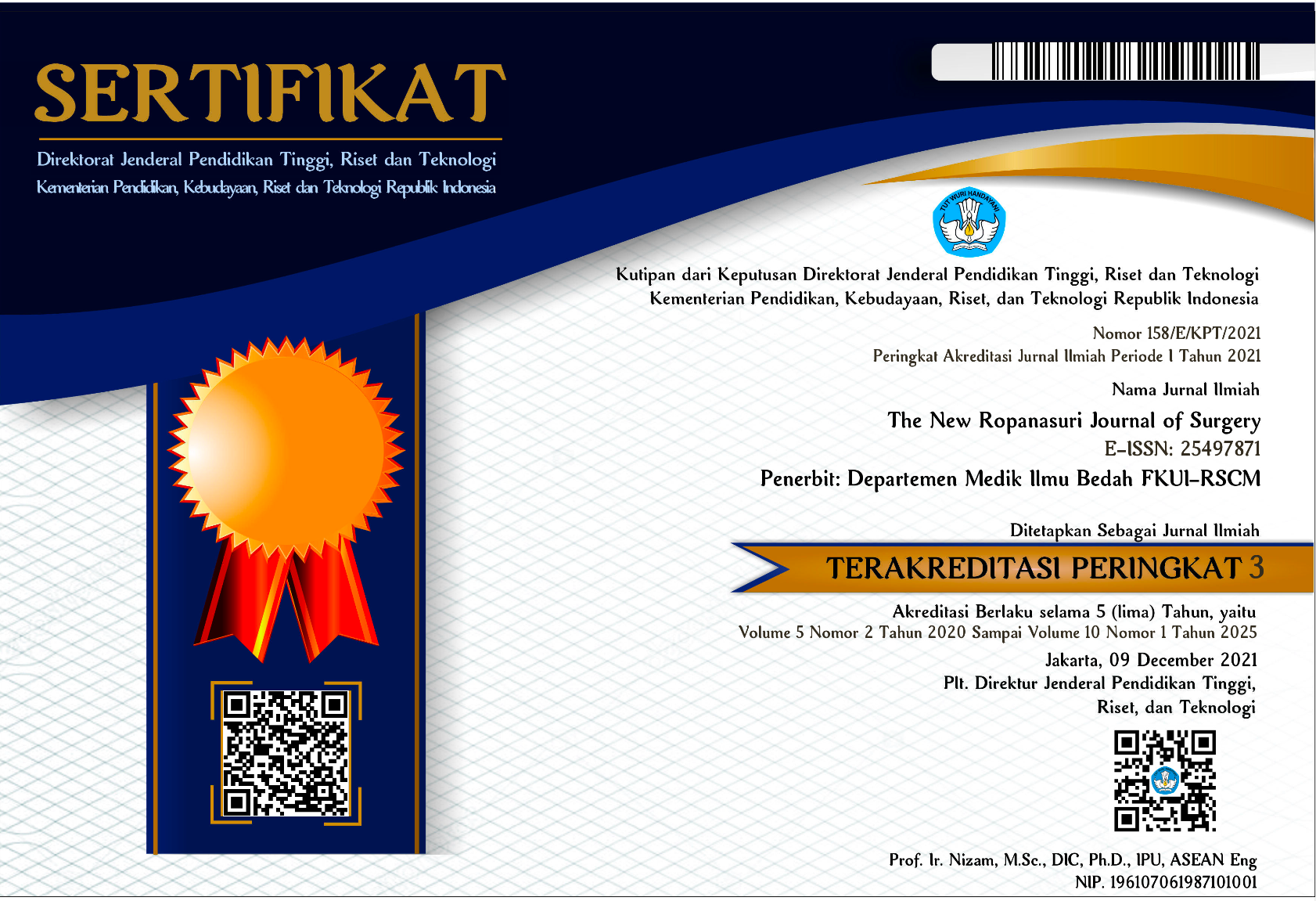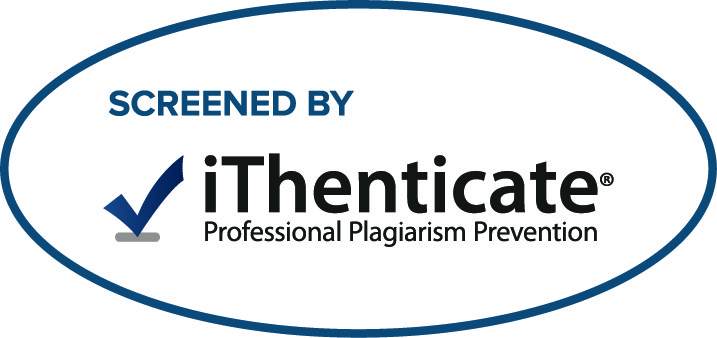Abstract
Background. The incidence of surgical site infections (SSIs) is reducing following the global campaign that requires all the stakeholder involvement. However, of all hospital-acquired infection prevention programs, wound irrigation is hard to be implemented in our hospital. There is a belief that the wound irrigation procedure leading to the spreading of infection. In contrast, the use of antiseptic and topical antibiotic, as well as systemic antibiotic, is uncontrolled high. Thus, we run a cost-effective study of wound irrigation to change the practice.
Method. We carried out a prospective cohort study comparing wound irrigation and the standard protocol in wound care in those underwent median laparotomy during the period of January to July 2018. A total of 80 subjects enrolled in this study, which divided into two groups, 40 for each group. The first group was those treated using antiseptics (povidone-iodine) and antibiotic contained paraffin tulle, while the second group was those treated using irrigation. This study performed in the digestive surgery division, which initiated irrigation protocol for wound irrigation. Stitch specimen taken for bacterial culture proceeded on 7th day postoperative and clinical signs of infection following CDC criteria was observed then statistically analyzed. The committee of ethics Faculty of Medicine Universitas Indonesia approved the study.
Results. The bacterial culture showed no significant difference (p = 0.82) between the two groups. Clinical signs are showing no significant difference between the two groups (p = 1.00). In the cost perspective, the application of wound irrigation saving IDR 57,500,00 or four USD per subject.
Conclusion. Wound irrigation using distilled water efficiently prevent SSIs.
References
- Centers for Disease Control and Prevention. Surgical Site Infection Event. 2015:27.
- Haryanti L, Pudjiadi AH, Ifran EKB, Thayeb A, Amir I, Hegar B. Prevalence and Risk Factor of Surgical Site Infection. Sari Pediatr. 2016;15(4):207. Doi:10.14238/sp15.4.2013.207-12 (text in Bahasa Indonesia).
- Simanjuntak B. Microbial Pattern in Complicated Intraabdominal Infection due to Perforated Gastrointestinal Tract. Thesis. Department of Surgery. Faculty of Medicine. Universitas Indonesia. 2014 (text in Bahasa Indonesia).
- Solomkin JS. Global Guidelines for the Prevention of Surgical Site Infection. 2016. http://www.who.int/gpsc/ssi-prevention-guidelines/
- Preas MA, O’Hara L, Thom AK. CDC Guideline for prevention of Surgical Site Infection: What the IP needs to know. Prev Strateg. 2017;10(3):69-72.
- Leaper DJ, Edmiston CE. World Health Organization: global guidelines for the prevention of surgical site infection. J Hosp Infect. 2017;95(2):135-6. doi:10.1016/j.jhin.2016.12.016
- WHO. Global Guidelines for the Prevention of Surgical Site Infection. Glob Guidel Prev Surg site Infect. 2016:1-185. doi:10.1016/j.jhin.2016.12.016
- Wu X, Kubilay NZ, Ren J, et al. Antimicrobial-coated sutures to decrease surgical site infections: a systematic review and meta-analysis. Eur J Clin Microbiol Infect Dis. 2017;36(1):19-32. doi:10.1007/s10096-016-2765-y
- Ashraf V, Awan AS. the Efficacy of Normal Saline Irrigation to Prevent Surgical Site Infection. 2015;65(1):65-7.
- Mueller TC, Nitsche U, Kehl V, et al. Intraoperative wound irrigation to prevent surgical site infection after laparotomy (IOWISI): Study protocol for a randomized controlled trial. Trials. 2017;18(1):1-5. doi:10.1186/s13063-017-2154-6
- Norman G, Atkinson RA, Smith TA, et al. Intracavity lavage and wound irrigation for prevention of surgical site infection. Cochrane Database Syst Rev. 2017;2017(10). doi:10.1002/14651858.CD012234.pub2
- Dumville JC, Gray TA, Eater CJ, et al. Dressings for the prevention of surgical site infection (Review). 2015;(7). doi:10.1002/14651858.CD003091.pub3.www.cochranelibrary.com
- Berríos-Torres SI, Umscheid CA, Bratzler DW, et al. Centers for Disease Control and Prevention Guideline for the Prevention of Surgical Site Infection, 2017. JAMA Surg. 2017. doi:10.1001/jamasurg.2017.0904
- O’Neal PB, Itani KMF. Antimicrobial Formulation and Delivery in the Prevention of Surgical Site Infection. Surg Infect (Larchmt). 2016;17(3):275-285. doi:10.1089/sur.2015.272
- Norman G, Dumville JC, Crosbie EJ. Antiseptics and antibiotics for surgical wounds healing by secondary intention summary of a Cochrane review. JAMA Dermatology. 2016. doi:10.1001/jamadermatol.2016.3131
- Li H, Sun S, Yap JQ, Chen J, Qian Q. 0.9% Saline Is Neither Normal nor Physiological. J Zhejiang Univ B. 2016;17(3):181-7. doi:10.1631/jzus.b1500201
- Diaz-Fuentes G, Bajantri B, Venkatram S. Fluids, and Sodium Imbalance: Clinical Implications. IntechOpen. 2018;i:1-32. http://dx.doi.org/10.5772/intechopen.79121.
- Henriksen NA, Meyhoff CS, Wetterslev J, Wille-Jørgensen P, Rasmussen LS, Jorgensen LN. Clinical relevance of surgical site infection as defined by the criteria of the Centers for Disease Control and Prevention. J Hosp Infect. 2010;75(3):173-177. doi:10.1016/j.jhin.2009.12.022
- Ortega G, Rhee DS, Papandria DJ, et al. An evaluation of surgical site infections by wound classification system using the ACS-NSQIP. J Surg Res. 2012;174(1):33-38. doi:10.1016/j.jss.2011.05.056
- Kokate SB, Rahangdale V, Katkar VJ. Study of Bacteriological Profile of Postoperative Wound Infections in Surgical Wards in a Tertiary Care Hospital. Int J Contemp Med Res. 2017;4(1):232-235.
- Macgregor L, Calne S, Day K, Jones J, Pugh A, Walker J. Wound Infection in Clinical Practice. Int Wound J. 2008;5(s3):iii-11. doi:10.1111/j.1742-481X.2008.00488.x
- Heal CF, van Driel ML, Lepper PD, Banks JL. Topical antibiotics for preventing surgical site infection in wounds healing by primary intention. Cochrane Database Syst Rev. 2014;2014(12). doi:10.1002/14651858.CD011426
- Loho T, Astrawinata DW, J K, R. S. Bacterial and Antibiotics Susceptibility Profile at Cipto Mangunkusumo Hospital July–December 2016. Jakarta; 2016.
Recommended Citation
Jeo, Wifanto S.; Pratama, Dennis W.; Vanto, Yoni; Kekalih, Aria; and Moenadjat, Yefta
(2020)
"Postoperative Wound Irrigation Using Distilled Water in Preventing Surgical Site Infection in a Tertiary Hospital: A retrospective Cohort and Cost-effective Study,"
The New Ropanasuri Journal of Surgery: Vol. 5:
No.
1, Article 2.
DOI: 10.7454/nrjs.v5i1.1074
Available at:
https://scholarhub.ui.ac.id/nrjs/vol5/iss1/2













